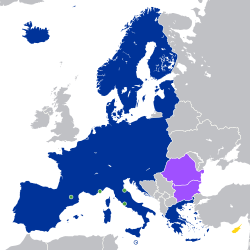Entry/Exit System
 Map of the Schengen Area
Schengen Area
Countries with open borders to the Schengen area
Future Schengen Area | |
| Policy of | |
|---|---|
| Type | Electronic system for border management |
| Start of implementation | 12 October 2025 |
| Complete implementation | 10 April 2026 |
| Applicable countries | |
| Website | travel-europe |
The Entry/Exit System (EES) is a system of the European Union for the automatic electronic monitoring and recording of border crossings of third-country nationals (non-EU/EEA/Swiss citizens) at all border crossings of the Schengen Area. The system, being operated by eu-LISA, is operational at some Schengen Area border checkpoints and will be operational at all Schengen Area border checkpoints by 10 April 2026, after which passport stamps will no longer be used upon entering or exiting the Schengen Area.[1][2] The system stores information including name, date of birth, fingerprints and biometrics for a facial recognition system, and locations and times of border crossings in a database of the European Travel Information and Authorisation System (ETIAS).[2]
Exemptions
[edit]The Entry/Exit system does not apply to the following classes of individuals:[3]
- Citizens of the following countries and regions: (dual citizens require a valid European passport or national identity card)
- Foreign citizens holding a:
- Residence permit or a residence card issued by an EU or Schengen country (including British beneficiaries of the Brexit Withdrawal Agreement)
- Long-stay schengen visa
- Valid local border traffic permit
The border process
[edit]The first time a traveler passes through the new EES system, they will need to provide a few personal details. A passport officer will take a picture of the individual’s face and/or scan their fingerprints. In some cases, travelers have the ability to register this information in advance, through a self-service system at specific border entry points, or through a mobile application called Travel to Europe, if it is available for your country of arrival/departure.
After a traveler has passed through EES for the first time and their data has been recorded, an agent will simply verify their identity for all subsequent entries. At some border crossing points, self-service kiosks will be available for those who have already passed through EES once before and hold biometric passports.
European Union Regulations
[edit]- Regulation (EU) 2017/2226 of the European Parliament and of the Council of 30 November 2017 establishing an Entry/Exit System (EES) to register entry and exit data and refusal of entry data of third-country nationals crossing the external borders of the Member States and determining the conditions for access to the EES for law enforcement purposes, and amending the Convention implementing the Schengen Agreement and Regulations (EC) No 767/2008 and (EU) No 1077/2011 (OJ L 327, 9 December 2017, p. 20)
- Regulation (EU) 2017/2225 of the European Parliament and of the Council of 30 November 2017 amending Regulation (EU) 2016/399 as regards the use of the Entry/Exit System (OJ L 327, 9 December 2017, p. 1)
References
[edit]- ^ "EU Readies for Phased Launch of Entry/Exit System". eu-LISA. 12 May 2025. Archived from the original on 16 May 2025. Retrieved 26 May 2025.
- ^ a b "Entry/Exit System". European Union. 14 April 2025. Archived from the original on 1 May 2025. Retrieved 26 May 2025 – via Europa.
- ^ "EES / ETIAS - European Union". travel-europe.europa.eu. Archived from the original on 31 August 2025. Retrieved 20 September 2025.
